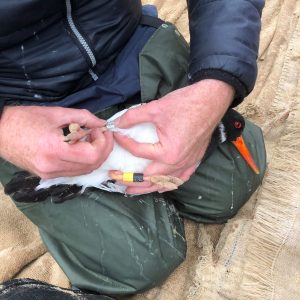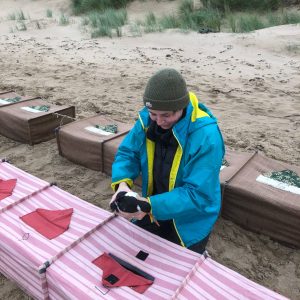On Saturday 23 October 2021, several members of the Gower Ringing Group (Colin Baker, Andrew Bevan, Becky Gibbs, Dan Jenkins-Jones and Wayne Morris) joined ringers from across Wales at Whiteford Sands to try and catch oystercatchers (Haematopus ostralegus) as part of long-term monitoring of the species around the Burry Inlet. Since the late 1980s, ringers have been cannon-netting flocks of oystercatchers to understand their long-term survival, growth patterns and movements around the area via recapturing ringed individuals and taking biometric data.
For this weekend, a small subset of the team turned up on the Friday evening to head down to the beach to set up the nets ready for the morning’s tide. Reconnaissance had been completed over previous days to identify which areas of the beach birds were using, and this guided the locations selected for the setting of nets. Three nets were placed in a line north to south. Then, after a short night’s rest, the full team met up early in the morning to head on down to the beach.
It turned out to be a dry catch (well above the tide for most of the morning) so covering material was placed over the birds, to keep them calm during extraction. Over 600 birds were captured, and so the clock was ticking to extract all the birds and get on with ringing – we always release all birds within four hours of capture (much of this time they would be roosting). Once all the birds had been extracted, two ringing teams were set up next to the keeping cages and birds were handed out to start ringing.
Each bird’s age was identified and written in the ringing book alongside the ring number prior to release. With smaller catches a processing team (moult, wing, head/bill, weight) would have been set up for birds to be sent, but given the size of this catch only a sample of 40 adults was fully processed.
The team also explained to the passing public what we had been doing as well. The nets and equipment were all packed away at midday and then everyone headed back to the National Trust house that had been acting as base for those travelling from further away.
It is funny how quickly the end comes after such a busy morning, but this was an excellent catch, the second largest that had happened in the area making up for recent missed years (Covid, illness and bad weather). Of the 691 birds, 90 were retraps, adding to our knowledge of the survival and movements of birds in the area, and the rest keeping the proportion of birds ringed in the flocks on Burry Inlet high.
One Icelandic retrap was included in these 90 which was great to see as well as two colour-ringed birds, one of which came from the Exe estuary.
Many thanks to the twenty ringers who came along to help with this catch, without your help and effort this would not have been half as efficient. Here is to next year!
A publication led by the BTO is currently in press with authorship led from some of the team on this catch that relied on the data from these catches to understand survival of oystercatchers on the Burry Inlet given the major cockle crash in the early 2000s. When it is published in full, we will circulate this to any who are interested: https://www.int-res.com/prepress/m13922.html
Katharine Bowgen & Steve Dodd, November 2021
Photographs, courtesy of Colin Baker are below


